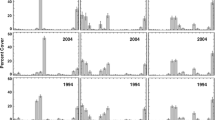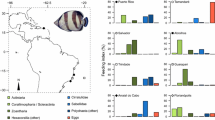Abstract
Increasing dietary specialization is an inherently risky strategy because it increases a species’ vulnerability to resource depletion. However, risks associated with dietary specialization may be offset by increased performance when feeding on preferred prey. Although rarely demonstrated, highly specialized species are expected to outperform generalists when feeding on their preferred prey, whereas generalists are predicted to have more similar performance across a range of different prey. To test this theory, we compared the growth rates of two obligate coral-feeding butterflyfishes (Chaetodon trifascialis and Chaetodon plebeius) maintained on exclusive diets of preferred vs nonpreferred prey. In the field, C. trifascialis was the most specialized species, feeding almost exclusively on just one coral species, Acropora hyacinthus. C. plebeius meanwhile, was much less specialized, but fed predominantly on Pocillopora damicornis. During growth experiments, C. trifascialis grew fastest when feeding on A. hyacinthus and did not grow at all when feeding on less preferred prey (P. damicornis and Porites cylindrica). C. plebeius performed equally well on both A. hyacinthus and P. damicornis (its preferred prey), but performed poorly when feeding on P. cylindrica. Both butterflyfishes select coral species that maximize juvenile growth, but contrary to expectations, the more specialized species (C. trifascialis) did not outperform the generalist species (C. plebeius) when both consumed their preferred prey. Increased dietary specialization, therefore, appears to be a questionable strategy, as there was no evidence of any increased benefits to offset increases in susceptibility to disturbance.



Similar content being viewed by others
References
Aeby GS (2002) Trade-offs for the butterflyfish, Chaetodon multicinctus, when feeding on coral prey infected with trematode metacercariae. Behav Ecol Sociobiol 52:158–165
Allen GR, Steene R, Allen M (1998) A guide to angelfishes and butterflyfishes. Odyssey Publishing, Perth
Almany GR (2004) Priority effects in coral reef fish communities of the Great Barrier Reef. Ecology 85:2872–2880
Bean K, Jones GP, Caley MJ (2002) Relationships among distribution, abundance and microhabitat specialisation in a guild of coral reef triggerfish (Balistidae). Mar Ecol Prog Ser 233:263–272
Berumen ML (2005) The importance of juveniles in modelling growth: butterflyfish at Lizard Island. Environ Biol Fishes 72:409–413
Berumen ML, Pratchett MS (2006a) Recovery without resilience: persistent disturbance and long-term shifts in the structure of fish and coral communities at Tiahura Reef, Moorea. Coral Reefs 25:647–653
Berumen ML, Pratchett MS (2006b) Effects of resource availability on the competitive behaviour of butterflyfishes (Chaetodontidae). Proceedings of the 10th International Coral Reef Symposium, pp 644–650
Berumen ML, Pratchett MS, McCormick MI (2005) Within-reef differences in diet and body condition of coral-feeding butterflyfishes (Chaetodontidae). Mar Ecol Prog Ser 287:217–227
Brown JS, Kotler BP (2004) Hazardous duty pay and the foraging cost of predation. Ecol Lett 7:999–1014
Dearing MD, Mangione AM, Karasov WH (2000) Diet breadth of mammalian herbivores: nutrient versus detoxification constraints. Oecologia 123:397–405
Dill L (1983) Adaptive flexibility in the foraging behavior of fishes. Can J Fish Aquat Sci 40:398–408
Ferry-Graham LA, Bolnick DI, Wainwright PC (2002) Using functional morphology to examine the ecology and evolution of specialization. Integrative and Comparative Biology 42:265–277
Fox LR, Morrow PA (1981) Specialization: species property or local phenomenon? Science 211:887–893
Gochfeld DJ (2004) Predation-induced morphological and behavioral defenses in a hard coral: implications for foraging behavior of coral-feeding butterflyfishes. Mar Ecol Prog Ser 267:145–158
Hoegh-Guldberg O (1999) Climate change, coral bleaching and the future of the world’s coral reefs. Mar Fresh Res 50:839–866
Hughes TP, Baird AH, Bellwood DR, Card M, Connolly SR, Folke C, Grosberg R, Hoegh-Guldberg O, Jackson JBC, Kleypas J, Lough JM, Marshall P, Nyström M, Palumbi SR, Pandolfi JM, Rosen B, Roughgarden J (2003) Climate change, human impacts, and the resilience of coral reefs. Science 301:929–933
Irons DK (1989) Temporal and areal feeding behaviour of the butterflyfish, Chaetodon trifascialis, at Johnston Atoll. Environ Biol Fishes 25:187–193
Irschick D, Dyer L, Sherry TW (2005) Phylogenetic methodologies for studying specialization. Oikos 110:404–408
Jenkins M (2003) Prospects for biodiversity. Science 302:1175–1177
Jones GP, Caley MJ, Munday PL (2002) Rarity in coral reef fish communities. In: Sale PF (ed) Coral reef fishes. Academic, San Diego, pp 81–102
Kuiter RH (2002) Butterflyfishes, bannerfishes and their relatives—a comprehensive guide to Chaetodontidae & Microcanthidae. TMC Publishing, Chorleywood, UK
MacNally RC (1995) Ecological versatility and community ecology. Cambridge University Press, Cambridge
Manly BFJ, McDonald LL, Thomas DL (1993) Resource selection by animals. Chapman and Hall, London
Moore BD, Foley WJ, Wallis IR, Cowling A, Handasyde KA (2005) Eucalyptus foliar chemistry explains selective feeding by koalas. Biology Letters 1:64–67
Motta PJ (1988) Functional morphology of the feeding apparatus of ten species of Pacific butterflyfishes (Perciformes, Chaetodontidae): an ecomorphological approach. Environ Biol Fishes 22:39–67
Munday PL (2004) Habitat loss, resource specialization, and extinction on coral reefs. Global Change Biology 10:1642–1647
Perry G, Pianka ER (1997) Animal foraging: past, present, and future. Trends Ecol Evol 12:360–364
Pratchett MS (2005) Dietary overlap among coral-feeding butterflyfishes (Chaetodontidae) at Lizard Island, northern Great Barrier Reef. Mar Biol 148:373–382
Pratchett MS, Wilson SK, Baird AH (2006) Declines in the abundance of Chaetodon butterflyfishes (Chaetodontidae) following extensive coral depletion. J Fish Biol 69:1269–1280
Pratchett MS, Wilson SK, Berumen ML, McCormick MI (2004) Sublethal effects of coral bleaching on an obligate coral feeding butterflyfish. Coral Reefs 23:352–356
Randall JE (2005) Reef and shore fishes of the South Pacific: New Caledonia to Tahiti and the Pitcairn Islands. University of Hawaii Press, Honolulu
Raubenheimer D, Simpson S (2004) Organismal stoichiometry: quantifying non-independence among food components. Ecology 85:1203–1216
Schoener TW (1971) Theory of feeding strategies. Ann Rev Ecolog Sys 2:369–404
Smith MJ (1979) Optimization theory in evolution. Ann Rev Ecolog Sys 9:31–56
Sorensen JS, Turnbull CA, Dearing MD (2004) A specialist herbivore (Neotoma stephensi) absorbs fewer plant toxins than does a generalist (Neotoma albigula). Physiol Biochem Zool 77:139–148
Stephens DW, Krebs JR (1986) Foraging theory. Princeton University Press, Princeton
Toft CA (1995) Evolution of diet specialization in poison-dart frogs (Dendrobatidae). Herpetologica 51:202–216
Tricas TC, Hiramoto JT (1989) Sexual differentiation, gonad development, and spawning seasonality of the Hawaiian butterflyfish, Chaetodon multicinctus. Environ Biol Fishes 25:111–124
Wilson SK, Graham NAJ, Pratchett MS, Jones GP, Polunin NVC (2006) Multiple disturbances and the global degradation of coral reefs: are reef fishes at risk or resilient? Global Change Biology 12:2220–2234
Acknowledgements
We thank Geoff Jones, Howard Choat, and three anonymous reviewers for their comments, which greatly improved the manuscript; and D deVere, D Pratchett, and J Pitt for the assistance in the field. This work was supported by a National Science Foundation (USA) Graduate Research Fellowship to MLB. These experiments comply with the laws of the country in which they were performed.
Author information
Authors and Affiliations
Corresponding author
Additional information
Communicated by T. Bakker
Rights and permissions
About this article
Cite this article
Berumen, M.L., Pratchett, M.S. Trade-offs associated with dietary specialization in corallivorous butterflyfishes (Chaetodontidae: Chaetodon). Behav Ecol Sociobiol 62, 989–994 (2008). https://doi.org/10.1007/s00265-007-0526-8
Received:
Revised:
Accepted:
Published:
Issue Date:
DOI: https://doi.org/10.1007/s00265-007-0526-8




